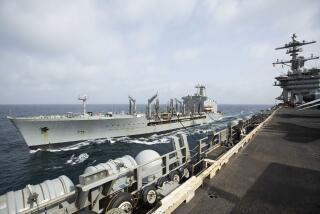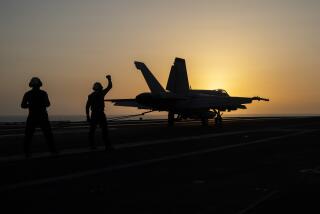Iran Planted Mine That Damaged Frigate, U.S. Officials Say
- Share via
WASHINGTON — The mine that tore a hole in a U.S. Navy frigate in the Persian Gulf was recently manufactured and was almost certainly planted by Iran, U.S. government sources said Friday.
The mine, of the same type as those seized aboard an Iranian mine-laying ship last September, was one of four spotted by the crew of the frigate Samuel B. Roberts shortly before an explosion ripped into the ship’s hull, officials said. Several sailors were injured in the blast, which started several fires in the engine room and caused “significant” hull and structural damage, the Pentagon said Friday.
“They’re Iranian,” a knowledge able Administration official said flatly, referring to the mines. Although of a World War I-era design, the mines apparently were manufactured recently in Iran, the official said.
Iranian authorities have denied planting mines in the gulf but have said that an “invisible hand” will strike U.S. warships and drive the Americans from the region. The warship is the first seriously damaged by a mine since the Navy began escorting re-registered Kuwaiti oil tankers last August to protect them against Iranian attack.
Ten sailors were injured in Thursday’s blast, three of them seriously. On Friday, four of the injured were reated for burns in a Bahrain hospital, five were receiving care aboard a supply ship in the gulf and one had been treated and returned to the Roberts.
Vice President George Bush, speaking to the American Society of Newspaper Editors in Washington on Friday, said that the mine recently had been placed in the central gulf and that the attack would not prompt the United States to reconsider its mission of protecting merchant shipping in the waterway.
“We must not permit one recently planted mine to deter our presence there,” Bush said. The Navy has 29 warships in or near the Persian Gulf.
The vice president’s comment was the first official statement that the mine was newly planted and not an older mine that had drifted from a known mine field farther north in the gulf, as Pentagon officials had originally suspected.
No mines had been sighted previously in the area where the Roberts was hit, about 70 miles east of the gulf island nation of Bahrain. On Thursday, lookouts aboard the Roberts sighted four mines and officers cut the ship’s speed to a crawl in heavy seas, according to Navy officials.
Moments later, a blast rocked the 445-foot guided-missile frigate, starting several small fires and flooding the engine room. The fires were quickly extinguished and the flooding was brought under control in an hour, Navy officials said. The Roberts, operating under auxiliary power, headed for Bahrain.
On Friday, the damaged frigate was met by a Navy tugboat, which began towing it toward Dubai, capital of the United Arab Emirates, where emergency repairs will be made at a commercial dry dock.
The Navy dispatched U.S. minesweepers to the gulf sector where the frigate was hit. The three remaining mines seen by the Roberts were located and destroyed by Navy minesweepers and helicopters Friday, the Pentagon said.
In Washington, White House spokesman Marlin Fitzwater refused to speculate on American retaliation for the mining.
“We never discuss future military actions. Obviously, our options are always open, but we don’t discuss future actions,” Fitzwater said.
Rep. Les Aspin (D-Wis.), chairman of the House Armed Services Committee, said in a television interview that he does not believe there is support for scaling down the U.S. escort policy in the gulf after the explosion.
“The time to withdraw forces is when there’s a lull, not when there’s been an attack,” Aspin said.
More to Read
Sign up for Essential California
The most important California stories and recommendations in your inbox every morning.
You may occasionally receive promotional content from the Los Angeles Times.










